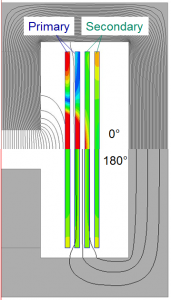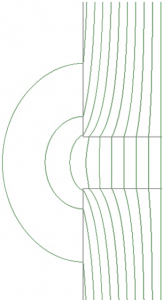I gave two presentations at the PSMA 2017 Magnetics Workshop. Brief summaries and slides are below.

Two-winding electrical core loss test setup.
The first was an introduction to core loss testing, and a survey of basic and advanced methods. Here are the slides: Survey of Core Loss Test Methods
It includes brief discussions of calorimetric methods and resonant methods. Calorimetric methods can be tedious, but are valuable as an independent check on other measurements. Resonant methods can improve accuracy at high-frequencies.

A simple 2:2 foil-winding transformer with current density and flux lines shown. In the top half, these are shown with the two windings excited with the same current, in phase. In the bottom half, they are 180 degrees out of phase. The losses are different by a factor of 4.
The second was a brief overview of magnetics modelling methods, including core and winding losses. The slides include a list of key references at the end.
As one example of what’s in the presentation, there’s an explanation of why it’s not adequate to model transformer winding loss with two frequency-dependent ac resistance values. As shown in this figure, the losses depend on the phase between the currents in the two windings, not just on their individual amplitudes. A model that correctly includes all the interactions between the windings is a resistance matrix.
Methods of finding the resistance matrix are discussed in the presentation and detailed in the references listed at the end.




